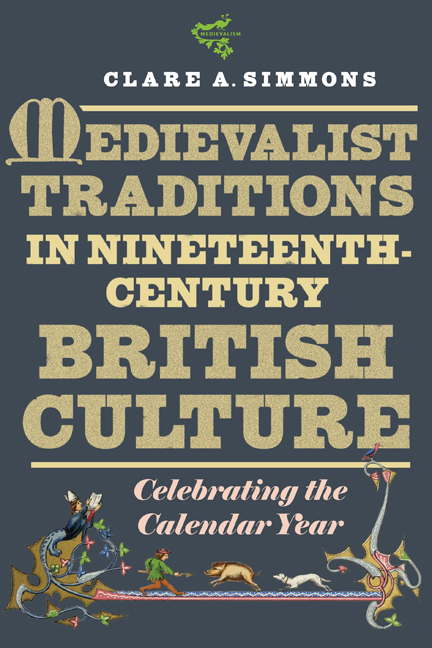Book contents
- Frontmatter
- Dedication
- Contents
- List of Illustrations
- Preface
- Acknowledgments
- List of Abbreviations
- Introduction: Medievalizing Time
- 1 The Christian and Not-So-Christian Year
- 2 Medievalist Calendar Experiments
- 3 Christmas Becomes a Season
- 4 Winter Love: St Agnes and St Valentine
- 5 Rites of Spring: Imagining Origins
- 6 Summer Festivals: Religion in Performance
- 7 Fragmented Autumn: Harvest-Home to Lord Mayor's Show
- Epilogue: Christmas Ghosts
- Bibliography
- Index
- Miscellaneous Endmatter
Epilogue: Christmas Ghosts
Published online by Cambridge University Press: 09 February 2021
- Frontmatter
- Dedication
- Contents
- List of Illustrations
- Preface
- Acknowledgments
- List of Abbreviations
- Introduction: Medievalizing Time
- 1 The Christian and Not-So-Christian Year
- 2 Medievalist Calendar Experiments
- 3 Christmas Becomes a Season
- 4 Winter Love: St Agnes and St Valentine
- 5 Rites of Spring: Imagining Origins
- 6 Summer Festivals: Religion in Performance
- 7 Fragmented Autumn: Harvest-Home to Lord Mayor's Show
- Epilogue: Christmas Ghosts
- Bibliography
- Index
- Miscellaneous Endmatter
Summary
MEDIEVALISM HAS a ghostly aspect, as the past continues to haunt the present. In the traditions noted in this study, the past tends to function as a friendly, helpful shadow, if all too ready to slip away. Accounts of British folk beliefs suggest that ghosts do not appear at Christmas: for example, W. Howells, in Cambrian Superstitions (1831), states of ghosts, “the usual time of their appearance is midnight, seldom before it is dark, and no ghosts can appear on Christmas eve.” This suggests that ghostly behavior had changed since medieval times, when spirits of the dead sometimes become visible in the hours before Matins or even in broad daylight; they almost invariably have a message that they convey to a living person. Peter the Venerable's De Miraculis moreover notes a number of miraculous events around Christmas, and makes specific mention of a ghost that appeared on Christmas Eve (Joynes, 44); Peter himself, who was Abbot of Cluny, was to die on Christmas Day, 1156.
Despite the absence of ghosts, British popular tradition clung to the idea of Christmas as a time of wonders. The constant present of Christmas so central to the Christmas carol takes a somewhat different form in other cultural practices associated with the disruption of nature and natural order. Antiquarians pointed to Christmas social activities that broke down hierarchies, and to folk beliefs that at Christmas Eve, the night that God took the form of humanity, nature itself might assume some supernatural aspects. The ghost story, however, is not a medieval genre but, as Joynes remarks, “a relatively recent literary development” (Joynes, xi), and the Christmas ghost story is still more recent. Even the most famous and the most presentist Christmas ghost story, Dickens's A Christmas Carol, makes use of, then expands, a newly invented tradition.
Gift-Books and Ghosts
In The Sketch Book, following the Christmas dinner, Geoffrey Crayon provides some hint of ghost stories. Sitting in a “venerable” oak chair, the parson shares “strange accounts of the popular superstitions and legends of the surrounding country,” including “several anecdotes of the fancies of the neighbouring peasantry, concerning the effigy of the crusader, which lay on the tomb beside the church altar.”
- Type
- Chapter
- Information
- Medievalist Traditions in Nineteenth-Century British CultureCelebrating the Calendar Year, pp. 185 - 202Publisher: Boydell & BrewerPrint publication year: 2021

